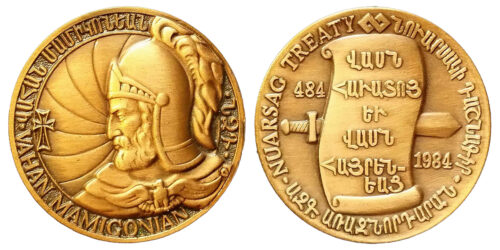
Historical Background
Christianity was adopted as the state religion in Armenia in the early fourth century (A.D. 301). Shortly thereafter, in the early fifth century (A.D. 405), Mesrop Mashtotz invented the Armenian alphabet, which ushered in the Golden Age of Armenian literature. The Bible and works of classical Greek writers were translated into Armenian and original literature on religion, history, geography, and science were composed.
During this period, Governors assigned by Byzantium ruled Western Armenia, and Marzpans appointed by the kings of Persia governed Eastern Armenia. Yazdgard II (A.D. 438-457) of Persia seeing that Christianity gave the Armenians a national identity and established a bond with the Christian Byzantine Empire, ordered the conversion of Armenia to the Persian Mazdaism religion. To achieve his purpose, he set up fire altars and sent Persian Magi to convert the Armenians to the Persian religion. Finding the situation intolerable, the Armenians destroyed the fire altars and drove the Magi out of the country. In anger, Yazdgard gathered an army of 300,000, reinforced by elephants, and marched on Armenia. The Armenians, under the leadership of Vardan Mamigonian, gathered their forces numbering 66,000 and met the enemy on the banks of the Tghmut River, in the plains of Shavarshakan, near the village of Avarayr. A decisive battle took place on 2 June A.D. 451. The Armenians lost the battle and General Vardan with 1036 of his followers fell on the battlefield. To this day, the Battle of Avarayr is celebrated by Armenians around the world. It is one of the major Armenian Church holidays and the nation pays tribute to its martyrs who sacrificed their lives for the cause of freedom of religion.
The Persian king soon realized that it was futile to try to convert the Armenians by force. He rescinded his previous orders, allowed the building of Armenian churches, and made other overtures to normalize relations. Some years later, when King Feruz II (A.D. 458-484) of Persia resumed the persecutions, the Armenians, under the leadership of Vardan’s nephew, Vahan Mamigonian, resorted to guerrilla warfare. Fortunately, Feruz’s successor Vologases (A.D. 484-488) considered it prudent to allow the Armenians to practice their religion rather than engage in constant battle.
The Treaty
A peace treaty was signed in 484 at Nuarsag and the following major points were adopted:
- Christianity was to be recognized as the legitimate religion of Armenia and its worship freely practiced. The fire altars were to be removed from Armenia.
- The rights and privileges of Nakharars (the Armenian princely houses) were to be restored. Nakharars were the ruling nobility class in ancient Armenia, holding various administrative and military responsibilities.
- In the event of disagreements or accusations, the king himself was to direct the investigation, require proof, and hear all sides before judgement.
- Armenians would recognize the sovereignty of the Persian king.
- Vahan Mamigonian was appointed as Marzpan (485-505) and Armenia enjoyed a period of peace and prosperity(1).
The Medal
In celebration of the 1500th anniversary of the Treaty of Nuarsag, the Prelacy of the Armenian Apostolic Church of America conceived the idea of striking a special medal in gold, silver, and bronze.
- Obverse: Clockwise in circular fashion to upper left, “ՎԱՀԱՆ ՄԱՄԻԿՈՆԵԱՆ” (Vahan Mamigonian), to right “-ՆՁԴ-” (A.D. 484); below, counterclockwise, “Vahan MAMIGONIAN.” In the field is the profile of Vahan Mamigonian turned left, with traditional headgear, gazing intently towards the cross. In the background is warrior’s shield with rays, symbolizing eternity. On the toga there is an eagle with wings spread.
- Reverse: In circular fashion clockwise at left, “NUARSAG TREATY” and at right, “..ՆՈՒԱՐՍԱԿԻ ԴԱՇՆԱԳԻՐ” (Treaty of Nuarsag); below, counterclockwise, “-ԱԶԳ. ԱՌԱՋՆՈՐԴԱՐԱՆ” (National Prelacy). On the unrolled parchment scroll representing the Treaty of Nuarsag, the six line legend reads, “ՎԱՍՆ ՀԱԻԱՏՈՅ ԵԻ ՎԱՍՆ ՀԱՅՐԵՆԵԱՑ” (for faith and fatherland). To the upper left of the scroll, the date “484” and to the lower right, the date “1984,” signifying the 1500th anniversary of the treaty. The horizontal sword behind the parchment signifies the struggle and sacrifices endured for Christianity and Armenia.
Specifications
Diameter of medal: 40 mm. Weight of medal: gold, 46.63 grams (numbered 001-1000); silver, 28.19 grams (numbered 1001-4000); and bronze, 23.55 grams (numbered 5001-9000). All medals are offered in velvet presentation case, individually or in collector’s set of three medals. The medal was designed by Grigoriy Gevorkian(2). The casting was carried out under the supervision of Puzant Khatchadourian of the Jaguar Casting Company in New York.
Nercessian, Y. T. “The Nuarsag Treaty Medal.” Armenian Numismatic Journal Series I, vol. XV, pp. 147-150, 1989.
References:
- Jacques de Morgan, The History of the Armenian People (Boston, 1965) and Vahan M. Kurkjian, A History of Armenia (New York, 1974). Note that material from both of these references has been used freely throughout the paper. A series of scholarly articles on the Treaty of Nuarsag can be found in the Armenian Review, Vol. 38 (1985), No. 3.
- Grigoriy Gevorkyan was born in Baku on 5 August 1932. He attended the elementary and secondary schools of Erevan. He graduated from the State Artistic and Theatrical Institute of the Armenian SSR in Erevan with a professional degree of “Graduate Sculptor-Artist” in 1960. After attaining the position of Chief Sculptor-Artist, in Soviet Armenia, he emigrated to the United States in December 1979 and is currently employed by Alva Museum Replica, Inc. in New York. The Armenian General Benevolent Union 75th anniversary commemorative medal is among his many works. Mrs. Zevart Gevorkyan is a journalist and their son, Garen, a painter.
- Armenian Numismatic Research Organization, “Nuarsag Treaty Medal,” ANRO website, accessed May 23, 2024, https://www.armnumres.org/items/show/1552.
